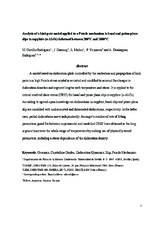Analysis of a kink pair model applied to a peierls mechanism in basal and prism plane slips in sapphire (α-Al2O3) deformed between 200° and 1800°C
Autor
Castillo-Rodríguez, Miguel
Castaing, J.
Muñoz, A.
Veyssière, P.
Domínguez-Rodríguez, A.
Editor
The American Ceramic SocietyFecha
2008Materia
CeramicsCrystalline oxides
Dislocation dynamics
Slip
Peierls mechanism
METS:
Mostrar el registro METSPREMIS:
Mostrar el registro PREMISMetadatos
Mostrar el registro completo del ítemResumen
A model based on dislocation glide controlled by the nucleation and propagation of kink pairs in a high Peierls stress crystal is revisited and modified to account for changes in dislocation densities and segment lengths with temperature and stress. It is applied to the critical-resolved shear stress (CRSS) for basal and prism plane slip in sapphire (α-Al2O3). According to agreed-upon knowledge on dislocations in sapphire, basal slip and prism plane slip are modeled with undissociated and dissociated dislocations, respectively. In the latter case, partial dislocations move independently. Among a number of sets of fitting parameters, good fits between experimental and modeled CRSS's are obtained in the long segment limit over the whole range of temperatures by making use of physically sound parameters, including a stress dependence of the dislocation density.

